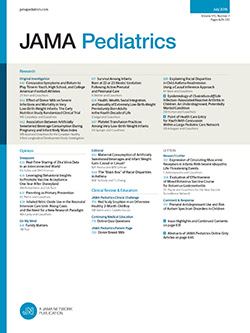父母在儿童早期的存在、健康和发展中使用技术
IF 24.7
1区 医学
Q1 PEDIATRICS
引用次数: 0
摘要
父母在孩子面前使用技术(以下简称PTU),通常被称为技术干预,是家庭动力学中日益受到关注的问题,没有研究定量地综合了与儿童健康和发展的关系。目的系统回顾和综合有关PTU儿童存在与儿童早期运动发育、认知发展、心理社会健康、身体活动、屏幕时间和睡眠之间关系的文献。数据来源来自MEDLINE, CINAHL, SPORTDiscus, PsycINFO, PsycArticles, Web of Science, Scopus和ProQuest的同行评审研究,从成立到2024年7月发表。研究选择最初共确定了6212项研究。如果研究在其表面健康的孩子(出生至4.9岁)在场的情况下检查PTU与运动发育、认知发展、社会心理健康、身体活动、屏幕时间或睡眠之间的关系,则纳入研究。数据提取和合成遵循prisma指南。采用随机效应模型来确定暴露类型(分心/中断)的关联和调节效应的汇总估计。使用JBI关键评估工具评估偏倚风险。儿童在场时的PTU与运动发育、认知发展、社会心理健康、身体活动、屏幕时间和睡眠之间的关系。结果共纳入21项研究,涉及来自10个国家的14900名受试者。发现父母在孩子在场时使用技术与认知之间存在显著关联(r = - 0.14;95% CI,−0.23至−0.04),内化行为和情绪(r = 0.13;95% CI, 0.08 ~ 0.19),外化行为(r = 0.15;95% CI, 0.09 ~ 0.21),亲社会行为(r = - 0.08;95% CI,−0.13 ~−0.02),附着(r =−0.10;95% CI,−0.19至−0.01)和屏幕时间(r = 0.23;95% CI, 0.13 ~ 0.32)。没有发现PTU暴露类型对任何关联的调节作用。没有研究考察运动发育、身体活动或睡眠。结论和相关性父母在孩子面前使用科技产品与幼儿的认知和心理社会结果以及屏幕时间呈负相关,尽管效应量很小。需要进一步研究对身体活动、睡眠和运动技能的潜在影响。了解这些关联对于为研究和指导方针提供信息至关重要,这些研究和指导方针旨在最大限度地减少这种现象对儿童早期发展的潜在负面影响。本文章由计算机程序翻译,如有差异,请以英文原文为准。
Parental Technology Use in a Child’s Presence and Health and Development in the Early Years
ImportanceParental technology use in a child’s presence (hereafter, PTU), often referred to as technoference, is a growing concern in family dynamics, and no studies have quantitatively synthesized associations with children’s health and development.ObjectiveTo systematically review and synthesize literature on associations between PTU in their child’s presence and motor development, cognitive development, psychosocial health, physical activity, screen time, and sleep in early childhood.Data SourcesPeer-reviewed studies from MEDLINE, CINAHL, SPORTDiscus, PsycINFO, PsycArticles, Web of Science, Scopus, and ProQuest published from inception to July 2024.Study SelectionA total of 6212 studies were initially identified. Studies were included if they examined associations between PTU in the presence of their apparently healthy children (birth to age 4.9 years) and motor development, cognitive development, psychosocial health, physical activity, screen time, or sleep.Data Extraction and SynthesisPRISMA guidelines were followed. Random-effect models were conducted to determine the pooled estimates of the associations and moderating effects of the type of exposure (distraction/interruption). The risk of bias was assessed using the JBI critical appraisal tools.Main Outcomes and MeasuresAssociation between PTU in the child’s presence and motor development, cognitive development, psychosocial health, physical activity, screen time, and sleep.ResultsTwenty-one studies involving 14 900 participants from 10 countries were included in the meta-analysis. Significant associations were found between parental technology use in the child’s presence and cognition (r = −0.14; 95% CI, −0.23 to −0.04), internalizing behavior and emotions (r = 0.13; 95% CI, 0.08 to 0.19), externalizing behavior (r = 0.15; 95% CI, 0.09 to 0.21), prosocial behavior (r = −0.08; 95% CI, −0.13 to −0.02), attachment (r = −0.10; 95% CI, −0.19 to −0.01), and screen time (r = 0.23; 95% CI, 0.13 to 0.32). No moderating effects of the type of PTU exposure on any associations were found. No study examined motor development, physical activity, or sleep.Conclusions and RelevanceParents’ use of technology in their child’s presence was negatively associated with cognitive and psychosocial outcomes and screen time among young children, although the effect sizes were small. Further research focusing on potential impacts on physical activity, sleep, and motor skills is needed. Understanding these associations is crucial for informing research and guidelines aimed at minimizing the potential negative effects of this phenomenon on early childhood development.
求助全文
通过发布文献求助,成功后即可免费获取论文全文。
去求助
来源期刊

JAMA Pediatrics
PEDIATRICS-
CiteScore
31.60
自引率
1.90%
发文量
357
期刊介绍:
JAMA Pediatrics, the oldest continuously published pediatric journal in the US since 1911, is an international peer-reviewed publication and a part of the JAMA Network. Published weekly online and in 12 issues annually, it garners over 8.4 million article views and downloads yearly. All research articles become freely accessible online after 12 months without any author fees, and through the WHO's HINARI program, the online version is accessible to institutions in developing countries.
With a focus on advancing the health of infants, children, and adolescents, JAMA Pediatrics serves as a platform for discussing crucial issues and policies in child and adolescent health care. Leveraging the latest technology, it ensures timely access to information for its readers worldwide.
 求助内容:
求助内容: 应助结果提醒方式:
应助结果提醒方式:


